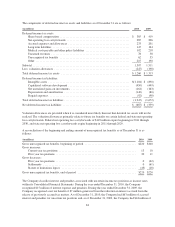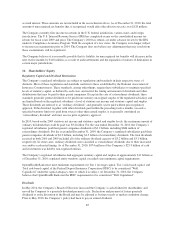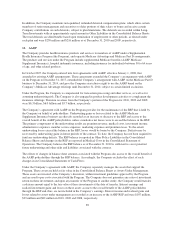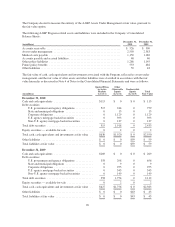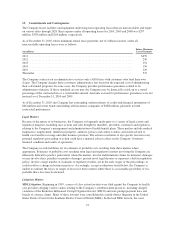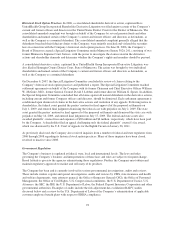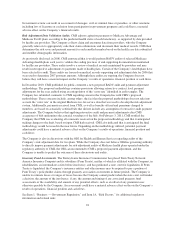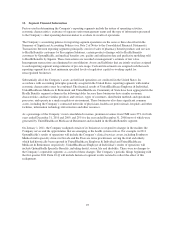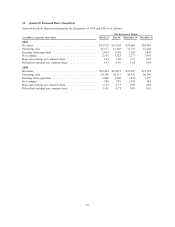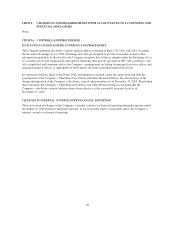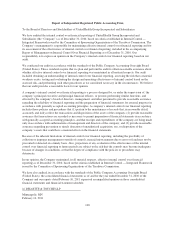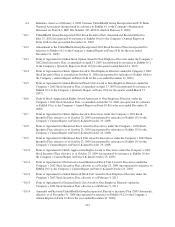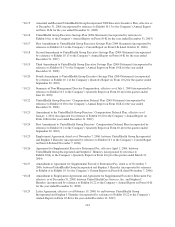United Healthcare 2010 Annual Report Download - page 96
Download and view the complete annual report
Please find page 96 of the 2010 United Healthcare annual report below. You can navigate through the pages in the report by either clicking on the pages listed below, or by using the keyword search tool below to find specific information within the annual report.Government actions can result in assessment of damages, civil or criminal fines or penalties, or other sanctions,
including loss of licensure or exclusion from participation in government programs and could have a material
adverse effect on the Company’s financial results.
Risk Adjustment Data Validation Audits. CMS adjusts capitation payments to Medicare Advantage and
Medicare Part D plans according to the predicted health status of each beneficiary, as supported by data provided
by health care providers. The Company collects claim and encounter data from providers, who the Company
generally relies on to appropriately code their claim submissions and document their medical records. CMS then
determines the risk score and payment amount for each enrolled member based on the health care data submitted
and member demographic information.
As previously disclosed, in 2008, CMS announced that it would perform RADV audits of selected Medicare
Advantage health plans each year to validate the coding practices of and supporting documentation maintained
by health care providers. These audits involve a review of medical records maintained by providers and may
result in retrospective adjustments to payments made to health plans. Certain of the Company’s health plans have
been selected for audit. These audits are focused on medical records supporting risk adjustment data for 2006 that
were used to determine 2007 payment amounts. Although these audits are ongoing, the Company does not
believe they will have a material impact on the Company’s results of operations, financial position or cash flows.
In December 2010, CMS published for public comment a new proposed RADV audit and payment adjustment
methodology. The proposed methodology contains provisions allowing retroactive contract level payment
adjustments for the year audited using an extrapolation of the “error rate” identified in audit samples. The
Company has submitted comments to CMS regarding concerns the Company has with CMS’s proposed
methodology. These concerns include, among others, the fact that the proposed methodology does not take into
account the “error rate” in the original Medicare fee-for-service data that was used to develop the risk adjustment
system. Additionally, payments received from CMS, as well as benefits offered and premiums charged to
members, are based on actuarially certified bids that did not include any assumption of retroactive audit payment
adjustments. The Company believes that applying retroactive audit and payment adjustments after CMS
acceptance of bids undermines the actuarial soundness of the bids. On February 3, 2011, CMS notified the
Company that CMS was evaluating all comments received on the proposed methodology and that it anticipated
making changes to the draft, based on input CMS had received. CMS also indicated that it anticipated the final
methodology would be issued in the near future. Depending on the methodology utilized, potential payment
adjustments could have a material adverse effect on the Company’s results of operations, financial position and
cash flows.
The Company is also in discussions with the OIG for Health and Human Services regarding audits of the
Company’s risk adjustment data for two plans. While the Company does not believe OIG has governing authority
to directly impose payment adjustments for risk adjustment audits of Medicare health plans operated under the
regulatory authority of CMS, the OIG can recommend to CMS a proposed payment adjustment, and the
Company is unable to predict the outcome of these discussions and audits.
Guaranty Fund Assessments. The Pennsylvania Insurance Commissioner has placed Penn Treaty Network
America Insurance Company and its subsidiary (Penn Treaty), neither of which is affiliated with the Company, in
rehabilitation, an intermediate action before insolvency, and has petitioned a state court for liquidation. If Penn
Treaty is liquidated, the Company’s insurance entities and other insurers may be required to pay a portion of
Penn Treaty’s policyholder claims through guaranty association assessments in future periods. The Company is
unable to estimate losses or ranges of losses because the Company cannot predict when the state court will render
a decision, the amount of the insolvency, if any, the amount and timing of any associated guaranty fund
assessments or the availability and amount of any potential offsets, such as an offset of any premium taxes
otherwise payable by the Company. An assessment could have a material adverse effect on the on the Company’s
results of operations, financial position and cash flows.
See Item 1, “Business — Government Regulation,” and Item 1A, “Risk Factors,” for additional regulatory
information and related risks.
94


